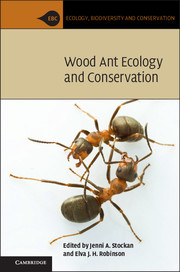Description
Wood Ant Ecology and Conservation
Ecology, Biodiversity and Conservation Series
Coordinators: Stockan Jenni A., Robinson Elva J. H.
A concise and contemporary synthesis of research into the ecology and conservation of wood ants, encompassing all known species.
Language: English
Subject for Wood Ant Ecology and Conservation:
Publication date: 07-2016
270 p. · 15.7x23.5 cm · Hardback
270 p. · 15.7x23.5 cm · Hardback
Description
/li>Contents
/li>Biography
/li>
Wood ants play an ecologically dominant and conspicuous role in temperate boreal forests, making a keystone contribution to woodland ecosystem functions and processes. Wood ant taxonomy and global distributions set the scene for this text's exploration of wood ants as social insects, examining their flexible social structures, genetics, population ecology, and behaviour, from nest-mate recognition to task allocation. Wood ants' interactions with their environment and with other organisms are essential to their success: competition, predation and mutualism are described and analysed. Bringing together the expertise of ecological researchers and conservation practitioners, this book provides practical and theoretical advice about sampling and monitoring these insects, and outlines the requirements for effective conservation. This is an indispensable resource for wood ant researchers, entomologists, conservationists and ecological consultants, as well as anyone interested in social insects, keystone species and the management and conservation of forest ecosystems.
1. Introducing wood ants: evolution, phylogeny and distribution Jenni A. Stockan, Elva J. H. Robinson, James Trager, Izumi Yao and Bernhard Seifert; 2. Wood ant reproductive biology and social systems Arnaud Maeder, Daniel Cherix, Christian Bernasconi, Anne Freitag and Samuel Ellis; 3. Population genetics of wood ants Pekka Pamilo, Perttu Seppä and Heikki Helanterä; 4. Where and why? Red wood ant population ecology Anita C. Risch, Samuel Ellis and Hayley Wiswell; 5. Colony and species recognition among the Formica ants Stephen J. Martin; 6. Interspecific competition and coexistence between wood ants Therese Johansson and Heloise Gibb; 7. Wood ant foraging and mutualism with aphids Timo Domisch, Anita C. Risch and Elva J. H. Robinson; 8. Wood ants and their interaction with other organisms Elva J. H. Robinson, Jenni A. Stockan and Glenn R. Iason; 9. Contribution of wood ants to nutrient cycling and ecosystem function Jan Frouz, Veronika Jílková and Jouni Sorvari; 10. Diversity, ecology and conservation of wood ants in North America James Trager; 11. Sampling and monitoring wood ants Anne Freitag, Jenni A. Stockan, Christian Bernasconi, Arnaud Maeder and Daniel Cherix; 12. Threats, conservation and management Jouni Sorvari; 13. Future directions for wood ant ecology and conservation Elva J. H. Robinson and Jenni A. Stockan.
Jenni A. Stockan is an entomologist and environmental researcher at the Department of Environmental and Biochemical Sciences, The James Hutton Institute, Aberdeen. Her research covers tree-insect interactions, and riparian and wetland ecology.
Elva J. H. Robinson is a Lecturer in Ecology at the Department of Biology, University of York. Her research area is the behavioural ecology of social animal groups, with particular focus on the organisation of ant societies.
Elva J. H. Robinson is a Lecturer in Ecology at the Department of Biology, University of York. Her research area is the behavioural ecology of social animal groups, with particular focus on the organisation of ant societies.
© 2024 LAVOISIER S.A.S.
These books may interest you

Insects and Pollution 220.72 €



